The Economics and Statistics Division maintains archives of previous publications for accountability purposes, but makes no updates to keep these documents current with the latest data revisions from Statistics Canada. As a result, information in older documents may not be accurate. Please exercise caution when referring to older documents. For the latest information and historical data, please contact the individual listed to the right.
<--- Return to Archive
For additional information relating to this article, please contact:
November 04, 2019STUDY: PROFILE OF YOUTH NOT IN EMPLOYMENT, EDUCATION OR TRAINING Statistics Canada has been examining youth not in employment, education or training (NEET) using data from the Canadian Community Health Survey (CCHS) collected in 2015-2017. The CCHS results allow for closer examination of characteristics such as perceived physical and mental health, mood/anxiety disorders, tobacco/alcohol/substance use, exercise and life satisfaction. This report summarizes Statistics Canada's findings.
The data compare the youth NEET population with the youth non-NEET population. The study looks further among the youth NEET population based on their reasons for being outside employment, education or training: those who are unemployed and actively seeking work, those who are caring for children or and those outside employment, education or training for other reasons such as household work, long-term illness, volunteering or care-giving (non-child).
These results are from three cycles of the CCHS from 2015 to 2017. The data reported here is stated at a national level for a sample of 13,270. Those excluded from the sample were: youth respondents in the summer months (when their education status is subject to change), youth under 18 (who are mostly enroled in mandatory education), persons living on reserves and other Aboriginal settlements, full-time members of the Canadian Armed Forces, the institutionalized population and persons living in the Quebec health regions of Region du Nunavik and Region des Terres-Cries-de-la-Baie-James. The upper age limit of 29 is based on the OECD convention for youth NEET analysis.
Based on the CCHS, 11.1 per cent of Canada's youth aged 18-29 were classified as NEET. Of these, 4.2 per cent were classified as "looking for paid work", 3.1 per cent were classified as "caring for children" and 3.8 per cent were classified as "other". Canada's NEET population shares characteristics with NEET populations in other OECD countries: youth NEET are more likely to be older (ages 25-29). Youth NEET are more likely to be married than non-NEET youth, but this is largely attributable to those NEET youth who are caring for children. Youth NEET had lower educational attainment than non-NEET youth and were more likely to live in lower-income households.
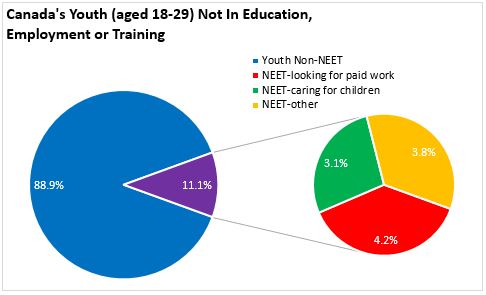
In health characteristics, youth NEET reported poorer perceived physical health than non-NEET youth, but this was particularly the case for those who were in the "other" NEET category.

Youth NEET also report poorer mental health perceptions than non-NEET youth. Poor mental health perceptions are more prevalent among those looking for work and those in the "other" category of youth NEET, but those caring for children reported similar mental health perceptions to non-NEET youth.
Just under one quarter (23.7 per cent) of youth NEET seriously contemplated suicide in the past year, compared with 14.9 per cent of youth non-NEET population. This was higher for "other" NEET youth (26.5 per cent) than for those looking for work (24.1 per cent) and those caring for children (20.4 per cent).
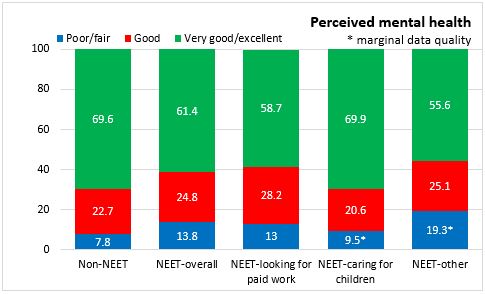
Mood and anxiety disorders are more prevalent among youth NEET than among non-NEET youth. Although this was the case for all three categories of NEET youth, mood and anxiety disorders were more prevalent among those in the "other" category.
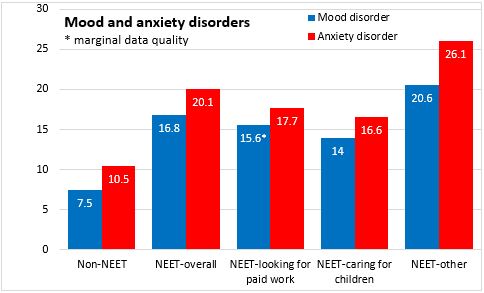
Youth NEET among all categories are more likely to be daily smokers (20.3 per cent) than non-NEET youth (10.0 per cent). However, youth NEET are less likely to engage in freqeunt binge drinking over the last year than non-NEET youth. However among youth NEET looking for paid work, binge drinking is almost as prevalent as among the non-NEET youth population. Overall youth NEET use of illicit drugs is similar to use among the non-NEET youth population. This average reflects much lower drug use among those caring for children and higher use among youth NEET populations looking for paid work and in the "other" category.
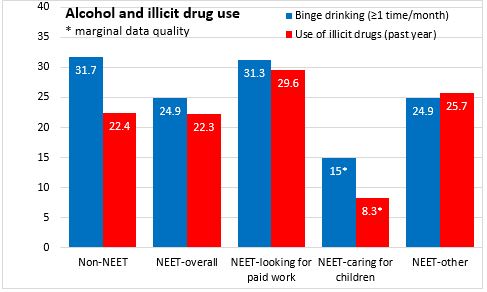
Overall life satisfaction is lower for youth NEET than for non-NEET youth populations. While 96.2 per cent of non-NEET youth report being satisfied or very satisfied with their lives, only 86.8 per cent of NEET youth are satisfied or very satisfied with their lives. Those youth NEET caring for children report higher life satisfaction (92.1 per cent satisfied or very satisfied) while those looking for work (85.3 per cent) and those in the "other" category (83.2 per cent) report lower life satisfaction.
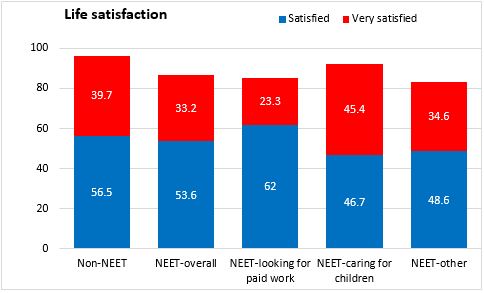
Statistics Canada also examined the influence of gender, age and educational attainment on these results for youth NEET and found that the differences among youth NEET and non-NEET populations mostly remained even after controlling for these variables.
Source: Davidson, Jordan and Arim, Rubab. A Profile of Youth Not in Employment, Education or Training (NEET) in Canada, 2015 to 2017. Statistics Canada: Analytical Studies Branch, November 4, 2019. Retrieved from: https://www150.statcan.gc.ca/n1/pub/11f0019m/11f0019m2019020-eng.htm
<--- Return to Archive